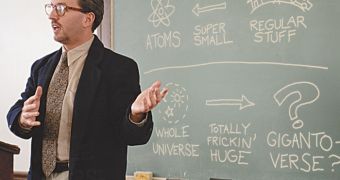Theoretical thinking certainly received a forward push in Monday's historic conference at Stanford University. World's brightest physicists gathered there to expose and discuss their revolutionary theories. Among the weirdest ideas stated was the one that suggests our universe is just a tiny atom in something way vaster.
MIT's Dr. Jacob Bozeman admitted that "The implications of this deceptively simple hypothesis are completely blowing my mind. Like, we could all be nothing more than this little dot in the fingernail of some giant dude. Or maybe a seed in the mustard of some really big sandwich, or even a germ on the back of a flea that's sitting on a hair on some giant dog."
Although certainly not new, the idea was brought to this particular conference by some particle physicists at Cal Tech. They came to think of this as they were sitting on a couch by the cyclotron of their Physics Department, comparing ceiling tile patterns while waiting for the pizza guy to come. This is just one of the ideas that scared the scientists, and there are many more, such as the concept of parallel (or "alternate") Earths or the multi-dimensional "superstrings" theory, which claims that superstrings fold forward and backward throughout the fabric of the universe.
Besides "forward and backward," the highest-level guest Stephen Hawkings advanced the possibility of "lateral" or "sideways" referring to time. In his own words, "If time goes sideways as well as forward, there might be other versions of this reality where, say, the Roman Empire is still in charge and stuff. By the way, ever think about what'd happen if you, say, went back in time and accidentally killed your own younger self?"
As a reaction to that, Dr. Wei Lo-Huang from Princeton exclaims: "I remember I was pretty wigged out when Feynman came up with that [theory] about antiparticles just being normal particles traveling backwards in time. [...] But now Hawking comes up with this? What is with that?" The physics specialist worries about the validity of his calculations and equations: "If this turns out to be true, it will require a total recalibration of all our methods for measuring space-time flux." Experts prefer to avoid thinking too much on the implications of such theories for now and just take them one at a time.
Some even believe these ideas went too far, like Dr. Sanjay Gupta, famous for his studies related to the theory of advanced quantum hydroponics. "It's like, one big atom? Forget about it, man. Even weirder is, like, if we're just one big atom in a larger universe, how do we know all the little atoms don't have, you know, little universes in them, with little people living on them, with little cars and little houses, and maybe even itsy-bitsy tiny[...] international symposiums on cutting-edge theoretical physics, even."

 14 DAY TRIAL //
14 DAY TRIAL //